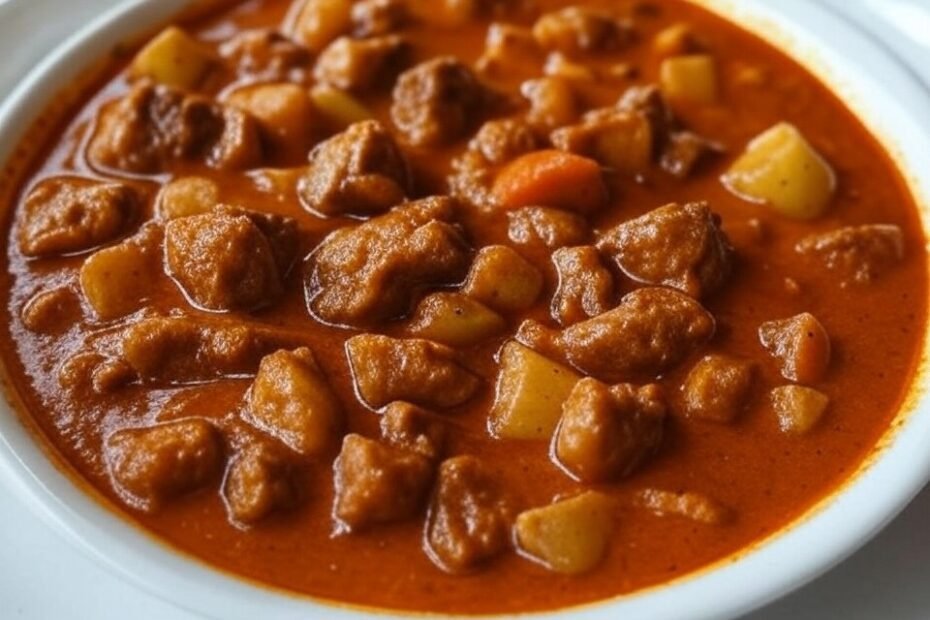I still remember the first evening I landed in Budapest. Coming from the humid chaos of Mumbai, the air felt almost crisp and new to me. I was tired after hours of walking with my backpack through cobblestone streets, gazing at grand old buildings that looked straight out of a history book. My stomach was growling, and all I wanted was a hot meal that would feel like home, even though I was so far away. That’s when I first heard the word “Gulyás.”
Gulyás, pronounced goo-yaash, is not just a soup or a stew—it’s a piece of Hungary’s soul. It started as a shepherd’s dish, slow-cooked over an open fire, and over centuries it has become one of the most iconic Hungarian foods. For me, it became the taste that tied my journey together.
First Encounters with Hungarian Food
My hostel friends, a mix of travelers from Europe and Asia, took me to a small eatery near the Danube River. The place had wooden benches, dim lights, and the smell of paprika floating in the air.
I ordered Gulyás, of course, but along the way I discovered other Hungarian gems too.
- Lángos: A fried flatbread topped with sour cream and cheese. It reminded me of a cousin of our bhatura but with an entirely new personality.
- Dobos Torte: A layered sponge cake with chocolate buttercream, finished with a thin caramel glaze. Too sweet for me at first bite, but it grew on me.
- Hortobágyi Palacsinta: Pancakes stuffed with meat and covered in paprika sauce, which strangely reminded me of Indian-style rolls but drenched in gravy.
But Gulyás remained my favourite. Maybe it was the chill in the Hungarian air or the way paprika coloured the broth red like a sunset, but it gave me warmth I didn’t know I was missing.
Learning the Recipe
A few days later, in a small town outside Budapest, I stayed with a local family through a cultural exchange program. The grandmother, Erzsébet, noticed how much I loved Gulyás. With the patience only a grandmother can have, she showed me how it’s really made—not the quick restaurant version, but the slow, heartfelt kind. I took notes carefully, because I knew I wanted to carry this taste back to Mumbai.
Here is the recipe she taught me.
Ingredients
- 500 g beef (preferably shin or shoulder), cut into small cubes
- 2 medium onions, finely chopped
- 2 tbsp sunflower oil or lard
- 2 tbsp Hungarian sweet paprika (substitute with Kashmiri red chilli powder if needed, but paprika is best)
- 2 cloves garlic, minced
- 1 medium tomato, chopped (or 1 tbsp tomato puree)
- 1 green pepper (capsicum), chopped
- 2 carrots, sliced into rounds
- 2 medium potatoes, diced
- 1 small parsnip (optional, can substitute with more carrot)
- 1 bay leaf
- Salt, to taste
- Freshly ground black pepper, to taste
- Water, about 1 to 1.5 litres
- Optional: csipetke (small Hungarian pinched noodles), but you can also drop in tiny pieces of homemade atta dough
Step by Step Method
- Heat the base
In a heavy-bottomed pot, heat the oil or lard. Add the chopped onions and sauté them on low heat until golden brown. This step is important—it gives body to the soup. - Add the paprika
Once the onions are golden, take the pot off the heat for a few seconds. Add the paprika powder and stir quickly so it doesn’t burn. This was Erzsébet’s tip—burnt paprika ruins the dish. - Brown the meat
Add the beef cubes and mix them well with the paprika and onions. Return to heat and let the meat brown slightly. The aroma at this stage fills the kitchen. - Flavour base
Add garlic, tomato, and green pepper. Stir and cook for a few minutes until the tomato softens. - Add water and simmer
Pour in about 1 litre of water, just enough to cover everything. Add salt, pepper, and the bay leaf. Bring it to a boil, then lower the heat and let it simmer gently for about 45 minutes. - Add vegetables
After the meat is halfway tender, add carrots, parsnip (if using), and potatoes. Continue simmering until both meat and vegetables are soft and the broth is rich. This can take another 30–40 minutes. - Finish with noodles (optional)
If making csipetke, pinch tiny pieces of dough and drop them into the pot 10 minutes before turning off the heat. They will cook right in the broth. - Serve hot
Traditionally, Gulyás is served with fresh bread. I think it would also go beautifully with pav or even plain steamed rice back in India.
Bringing It Back Home
As I sat there in her small kitchen, sipping Gulyás straight out of a deep bowl, I thought of how much this dish reminded me of Indian curries. It has the same patience, the same love for spices, and the same idea of gathering people around a warm pot.
When I return to Mumbai, I know I’ll cook it for my friends and family. It will probably taste a little different—our beef is not the same, our vegetables too—but the soul of it will remain. It will be my story from Hungary, told not through words or photos, but through a bowl of steaming Gulyás.
Prep and Cooking Details
- Prep Time: 20 minutes
- Cook Time: 1 hour 15 minutes
- Total Time: 1 hour 35 minutes
- Serves: 4
Nutrition (per serving, approximate)
- Calories: 350–400 kcal
- Protein: 25 g
- Fat: 15 g
- Carbohydrates: 30 g
- Fibre: 5 g
- Sodium: depends on added salt
